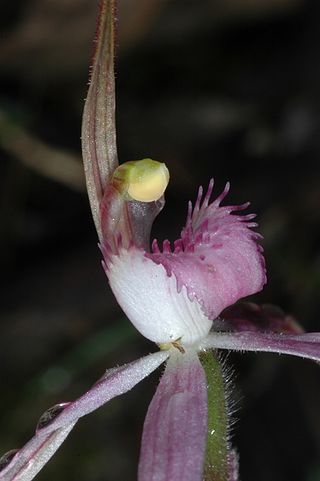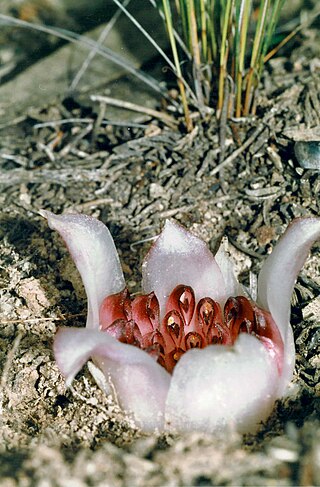
Rhizanthella, commonly known as underground orchids, is a genus of flowering plants in the orchid family, Orchidaceae and is endemic to Australia. All are leafless, living underground in symbiosis with mycorrhizal fungi. The inflorescence is a head of flowers held at, or just above the ground but mostly covered by soil or leaf litter and little is known about the mechanism of pollination.

Caladenia arenaria, commonly known as the sand-hill spider orchid, is a plant in the orchid family Orchidaceae and is endemic to New South Wales. It is a ground orchid with a single, densely hairy leaf and one or two white or pale yellow flowers with maroon tips. Formerly much more widespread, it is now only known from about two thousand individual plants in five locations in the Riverina area and is classed as "Endangered".
Caladenia audasii is a plant in the orchid family Orchidaceae and is endemic to Victoria. It is a rare ground orchid with a single hairy leaf and a single yellow flower.

Caladenia concolor, commonly known as the crimson spider orchid, is a plant in the orchid family Orchidaceae and is endemic to the south-east of Australia. It is a ground orchid with a single, sparsely hairy leaf, and one or two hairy, dark purplish-red flowers.

Caladenia rosella, commonly known as the rosella spider orchid is a plant in the orchid family Orchidaceae and is endemic to south-eastern Australia. It is a ground orchid with a single hairy leaf and a single scented pink flower. Although it may have had a wider distribution in the past, the total number of plants in 2000 was estimated to be 120 in four populations in Victoria. There is a single record from New South Wales but the orchid is classified as "extinct" in that state.

Pterostylis despectans, commonly known as the lowly rustyhood, is a plant in the orchid family Orchidaceae and is endemic to south-eastern Australia. It has a rosette of leaves at its base and up to six flowers on long stalks, branching off a short flowering stem. The flowers have an insect-like labellum and often touch the ground.

Pterostylis ventricosa, commonly known as the pot-bellied greenhood orchid, is a recently described and critically endangered species of orchid endemic to a small area of New South Wales, Australia. As with similar orchids, the flowering plants differ from those which are not flowering. The non-flowering plants have a rosette of leaves but the flowering plants lack a rosette at the base but have up to six tiny green, white and brown flowers.

Pterostylis vernalis, commonly known as the spring tiny greenhood, is a species of orchid endemic to New South Wales. As with similar orchids, the flowering plants differ from those that are not currently flowering. Non-flowering plants have a rosette of leaves at the base. Flowering plants lack that rosette, but have one or two rosettes on lateral growths. The flowers are green, brown and white. This greenhood is only known from a small area near Nowra.
Prasophyllum apoxychilum, commonly known as the tapered leek orchid, is a species of orchid endemic to Tasmania. It has a single tubular, green leaf with a purplish base and up to twenty light green and whitish flowers. It is very similar to P. truncatum, and there is some doubt as to whether the two species are distinct. The species is known from twenty widely separated populations and is usually only seen in disturbed sites, such as after fire.
Prasophyllum bagoense, commonly known as the Bago leek orchid, is a species of orchid endemic to a small area of southern New South Wales. It has a single tubular, green leaf and up to thirty scented, pale tawny green flowers on a flowering stem. It grows in subalpine grassland in a single population near Tumbarumba.

Prasophyllum fuscum, commonly known as the slaty leek orchid or tawny leek orchid, is a species of orchid endemic to a small region of New South Wales. It has a single tubular green leaf and up to thirty greenish brown to reddish brown flowers. There is debate about the taxonomy of the species with some authorities considering Prasophyllum uroglossum as a separate species. Only about twenty five plants are known to survive in south-western Sydney.
Prasophyllum keltonii, commonly known as Kelton's leek orchid, is a species of orchid endemic to a small region of New South Wales. It has a single tubular, bright green leaf and up to twenty two scented, green, brownish-red or purplish flowers. It is a very rare orchid with only a few hundred plants known.
Genoplesium littorale, commonly known as the Tuncurry midge orchid, is a species of small terrestrial orchid endemic that is endemic to New South Wales. It has a single thin leaf fused to the flowering stem and up to thirty small green flowers with a purple-brown labellum. It is only known from fewer than two thousand plants in a small area on the New South Wales North Coast and is critically endangered.
Genoplesium insigne, commonly known as the dark midge orchid or Wyong midge orchid is a species of small terrestrial orchid that is endemic to New South Wales. It has a single thin leaf and up to twelve dark purple to dark reddish purple flowers. It is mostly found in heath on the Central Coast and only around fifty plants survive.

Genoplesium rhyoliticum, commonly known as the Pambula midge-orchid or rhyolite midge orchid and as Corunastylis rhyolitica in Australia, is a species of orchid endemic to New South Wales. It is a small orchid with up to eighteen dark, purplish-black flowers and is only known from six sites on the south coast where it grows in shallow soil over rhyolite.
Diuris bracteata is a species of orchid which is endemic to New South Wales. It has two folded leaves and up to eight yellow flowers with blackish marks. After its collection in a Sydney suburb in 1888, no further collections were made and the species was presumed extinct until 2004 when it was rediscovered near Gosford.

Arthrochilus huntianus, commonly known as common elbow orchid, is a flowering plant in the orchid family (Orchidaceae) and is endemic to south-eastern Australia. It has no leaves but an insect-like flower which has its labellum dangling like a lure away from the rest of the flower. Because of its thin, wiry stem and small, dull-coloured flowers, this orchid is difficult to locate. Like others in the genus, the flowers are pollinated by a species of thynnid wasp. Some authorities use the name Thynninorchis huntiana for this orchid.

Corybas dowlingii, commonly known as red lanterns, is a rare species of terrestrial orchid endemic to New South Wales. It grows in colonies and has a round or heart-shaped leaf and a dark purplish red flower with white patches in the labellum.
Rhizanthella speciosa is a species of flowering plant in the orchid family and is endemic to Barrington Tops in New South Wales. It is a mycoheterotrophic herb that spends its entire life cycle, including flowering, at or below the soil surface. As at September 2020, R. speciosa has not yet been accepted as a valid name by the World Checklist of Selected Plant Families or the Australian Plant Census.

Rhizanthella johnstonii, commonly known as south coast underground orchid, is a species of flowering plant in the orchid family and is endemic to the southwest of Western Australia. It is a subterranean herb that has a horizontal rhizome and a head of up to sixty small white flowers with a pink tinge, surrounded by relatively large, cream-coloured to pale pinkish cream bracts.













